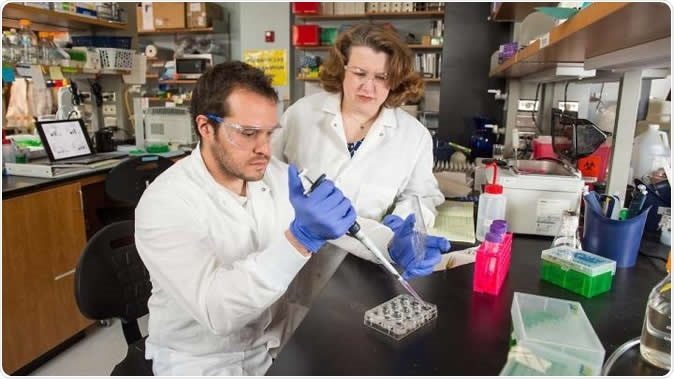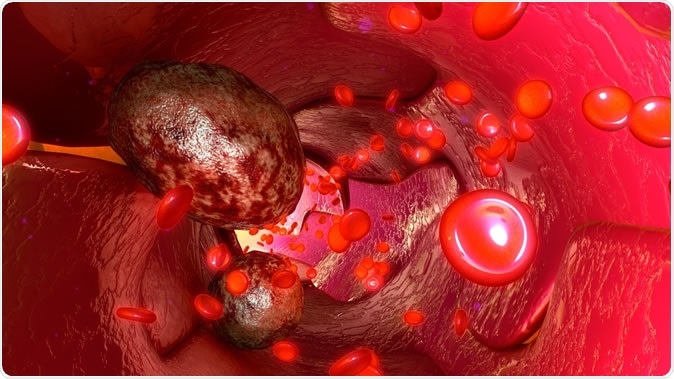In breast cancer patients with metastatic disease, bone is the most common site of metastasis and the most common site of first distant relapse, with roughly half (48%) of breast cancer patients developing bone metastases after treatment.
At death, roughly 73% of women with breast cancer have bone metastasis, mostly growing in highly vascularized bones. Dormant cancer cells in bone contribute to the majority of tumor relapses and treatment failures by escaping cytotoxic therapy due to their failure to actively divide. At the same time, the activation of these dormant cells at any point can lead to tumor formation in the bone itself. What causes this transformation to start and how can we stop it from occurring? In an attempt to help answer this question, scientists have found a pair of proteins that is fundamental to the process of cancer spread. The study titled 'The CXCL5/CXCR2 axis is sufficient to promote breast cancer colonization during bone metastasis' is published in the journal Nature Communications.

Scientist Laurie Littlepage works with graduate student Ricardo Romero Moreno in her lab at the Harper Cancer Research Institute. Image Credit: Barbara Johnston/University of Notre Dame.
Bones and cancer metastasis
In metastatic cancer, tumor cells travel through the blood to reach the bone. The bone is typically a very vascular structure, with an architecture that promotes the entry of the circulating tumor cells (CTCs). These may lie sleeping for a long time, with metabolic activity but without either active cell division or growth. The dormant nature of these cells enables them to escape detection. These cells also fail to be eliminated by typical radiation or chemotherapy, which are directed at actively growing cells. This is one major reason for treatment failures and relapses following cancer therapy.

Tumour cells in blood vessels 3d illustration. Image Credit: Sciencepics / Shutterstock
The bone microenvironment is involved in the final switch of CTCs to the phenotype of disseminated tumor cells (DTCs), which colonize the bone and bone marrow, producing a tumor. These cells actually give rise to new tumors, called breast cancer in bone, with their own characteristics in some respect. This therefore gives scientists multiple challenges to deal with, accounting for the fact that though extremely common, bone metastases in breast cancer are incurable.
Finally, the bone metastasis itself gives rise to new growths in other parts of the body through the many vascular channels and large venous lakes that allow cancer cells to enter and leave the bone in viable form. The bone interacts with this process in a complex crosstalk of growth promoters and inhibitors in the form of chemical molecules. The step which determines the rate of tumor formation in metastatic growths is the conversion of some dormant cells to colonizing cells. This could occur over years or sometimes even tens of years.
The current study was focused on this turning point – as researcher Laurie Little says: “Our team at the Harper Cancer Research Institute developed a model to study this critical moment -- when breast cancer cells travel to the bone and begin to proliferate, or colonize, to form a tumor -- so that we can get a better grasp on how to prevent and eliminate these tumors.”
CXCL5 and CXCR2 – paired for life
Once the model was in place, they looked at the whole process in minute detail to pick out factors that could trigger the activation of breast cancer cells in bone, or on the contrary, suppress their proliferation and promote their going into a dormant state. They found a pair of proteins which were promising candidates for promoters of this transition. One of these proteins is CXCL5, and it promotes cancer cell growth in interaction with its binding receptor, CXCR2.
This pair of proteins acts on both metastatic and non-metastatic cells, stimulating their rapid proliferation and spread throughout both the bone and the bone marrow. CXCL5 has been found to stimulate new blood vessel growth, migration of cancer cells and invasion of underlying or surrounding tissues, local recruitment of neutrophils and is associated with a poor response to chemotherapy. The other protein, CXCR2, was the receptor for this factor, and had been found, in earlier research, to be a marker for a poor prognosis following chemotherapy.
In the current study, they found the CXCL5 protein was sufficient by itself to promote cancer cell proliferation in cell cultures containing quiescent or dormant tumor cells as well as increasing the rate of proliferation in cultures of cancer cells. This protein is widespread, being found in bone marrow as well as in breast cancer mets in bone, and in breast carcinoma cells in culture, where it induces a host of reactions causing epithelial cells to transform to mesenchymal cells, losing their differentiation and becoming highly mobile migration-ready CTCs.
Now the team introduced an inhibitor to block the receptor from binding CXCL5. The signaling pathway activated by the binding of the protein to its receptor was thereby inhibited, successfully keeping the cancer cells in the metastatic bone site from growing and multiplying rapidly. They finally tested out their hypothesis on a human sample of bone containing metastatic breast cancer and found that both these proteins were present.
Importance of this study
The implications of this finding are that targeted therapies can now be developed to disable this protein-receptor binding, to treat metastatic breast cancer or other cancers that spread to the bone. The availability of options to treat these hitherto incurable tumors could transform the way all cancers that metastasize to bone are viewed and treated. The study also identifies other factors produced in bones primed with cancer cells, which need to be studied in greater detail to help understand and effectively prevent or treat this process.
Journal reference:
The CXCL5/CXCR2 axis is sufficient to promote breast cancer colonization during bone metastasis. Ricardo Romero-Moreno, Kimberly J. Curtis, Thomas R. Coughlin, Maria Cristina Miranda-Vergara, Shourik Dutta, Aishwarya Natarajan, Beth A. Facchine, Kristen M. Jackson, Lukas Nystrom, Jun Li, William Kaliney, Glen L. Niebur & Laurie E. Littlepage. Nature Communications volume 10, Article number: 4404 (2019). https://doi.org/10.1038/s41467-019-12108-6. https://www.nature.com/articles/s41467-019-12108-6#article-info